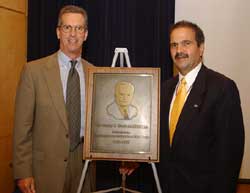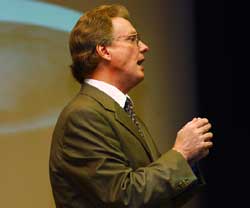Goddard
Dedicates Building 3 Auditorium to Dr. Harry Goett, First GSFC Director
 |
| |
Dr.
Goett's son, Andrew, and Mr. Diaz stand beside the plaque commemorating
the dedication of the auditorium. |
Goddard
hosted a special history colloquium this week as part of the official
dedication of the Building 3 auditorium to the memory of Dr. Harry
Goett, Goddard's first Center Director.
Steve
Garber, the NASA Historian, and Roger Launius, a historian at the
National Air and Space Museum and the former NASA Historian, both
spoke at the colloquium. Also in attendance was Dr. Goett's son,
Andrew, who also spoke briefly at the dedication.
 |
| |
Dr.
Roger Launius makes some remarks at the dedication ceremony. |
Following
Dr. Launius' presentation, Mr. Diaz gave the following remarks.
A.
V. Diaz: Now,
it's my distinct honor to officially dedicate this auditorium to Goddard's first
director, Dr. Harry Goett. Harry
J. Goett was an early pioneer in America's first missions into space and the first
Center Director of NASA's Goddard Space Flight Center. He served in that capacity
from September 1959 to July 1965. He
died in January 2000 at the age of 89. Dr.
Goett accepted the position as the first director of NASA's new aerospace research
facility - which of course was later renamed the Goddard Space Flight Center -
in 1959. When
Goett was named as Director of the new facility, it was still under construction.
Originally, NASA intended this center to manage all aerospace research. As the
scope of the aerospace program quickly grew, however, Goddard's mission re-focused
on the unmanned Earth-orbiting satellite projects, with emphasis on scientific
research of space. Goddard
managed most of NASA's early unmanned Earth-orbiting satellite missions. Some
of these early missions were started by ARPA and then transferred to NASA after
it was created on October 1, 1958. As
Director of Goddard, Goett had responsibility for all the Center's missions and
objectives in the field of space flight and scientific and satellite programs
and projects. These included design and development of scientific, communications
and weather satellites, sounding rockets and two world-wide tracking networks
for manned and scientific space missions. Starting
in early 1959, Goddard scientists, either in their role as project managers or
as project scientists, began to organize these new NASA missions. Goddard scientists
selected the scientists who flew instruments on Explorers 8, 10, 11, and 12. During
his tenure as Director, some 35 Goddard satellite projects, carrying over 100
scientific experiments, were successfully placed into orbit. These projects included
NASA's first international satellites. In
addition to his place in history as the first director of this Center, Dr. Goett
was instrumental in defining what a National Aeronautics and Space Administration
should actually do. In
1958, NACA was absorbed into the newly formed NASA. Initially, Harry chaired the
NASA committee (the Goett Committee) that developed the agency's early space research
agenda. The
group's work included early discussions on the national booster program, planning
for the man-in-space effort and work on space and reentry flight research. The
Goett Committee made a moon landing and return as NASA's major long range manned
space flight goal. As
Goett later remarked: "A primary reason for this choice was the fact that
it represented a truly end objective which was self-justifying and did not have
to be supported on the basis that it led to a subsequent more useful end." In
his book, Beyond the Atmosphere: Early Years of Space Science, author Homer Edward
Newell wrote of Goett: "Harry
Goett assumed the directorship of Goddard in September 1959. As was his nature
he quickly entered personally into every aspect of the center's work. From his
first day until he left, he kept in close touch with every project. As an untiring
battler for the center and his people, Goett endeared himself to his coworkers.
He was a warm, emotional person who showed a deep interest in the men and women
working for him, and on both sides a deep affection developed. "Goett
was beloved of his people; he had been a conscientious, hard-working, imaginative
director, under whose regime the center had achieved most of the space accomplishments
of NASA's first few years. Goett himself had played a key role in establishing
a productive relationship with the academic community." Today,
we honor a true space pioneer. Harry Goett was one of us, he belonged to the Goddard
family. He was an inspiring leader, a cherished friend and a loyal colleague.
In
closing, Mr. Diaz read an excerpt from a note that Dr. Goett's wife, Barbara,
who will soon turn 90 this year, sent him thanking GSFC for the invitation to
attend the ceremony. "Harry
loved Goddard very much, and I think things go well when one's heart is so thoroughly
in the job. I thank you and all of the personnel for your honor you are according
Harry.
Barbara Goett and the Family Andrew
Goett: On
behalf of my family, I want to thank Mr. Diaz, the Goddard community, and NASA
for the honor of naming this auditorium in memory of my father, Harry Goett. My
father had a great affection for Goddard Space Flight Center, its mission and
the people he worked with here. He
regarded his tenure at Goddard as the pinnacle of his professional career, which
spanned almost 50 years, covering the development of high speed propeller aviation
through the commercial applications of space technologies in communications. He
took great pride in the achievements of the Center and the dedication of its staff
to engineering and scientific excellence. Long
after he left Goddard, he continued to maintain close contact with the people
here and to follow the accomplishments of the Center with keen interest. I know
he would be very grateful for the honor you have given him.


| 





![]()
![]()
![]()
![]()
![]()